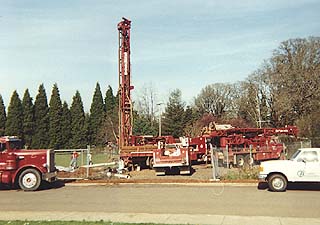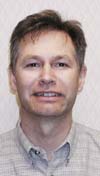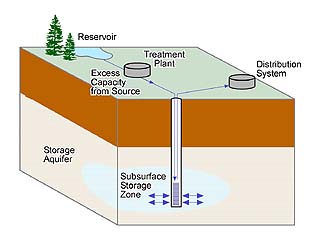
Surveys
DJC.COM
July 25, 2002
Water storage goes underground
Golder Associates

Photo courtesy of Golder Associates Salem, Ore., uses an ASR system during peak summer months.
|
Aquifer storage and recovery (ASR) is a water resource management technique in which water is introduced into permeable geological formations using wells or infiltration basins, stored for a period of months or years, and then recovered for use.
Although ASR is a well-established water resources management approach applied elsewhere in the United States and increasingly in Europe and Australia, it is a relatively new concept to the Pacific Northwest. It has become far more desirable now that growth and environmental regulations have placed new demands on existing water supplies.

Banton |

Pitre |
For instance, it has become increasingly difficult to obtain water rights in Washington because of the need to meet in-stream flow needs, particularly during the summer months. Both public and private entities are now looking at alternative water resource management techniques. ASR is an alternative where existing water rights are used to their full capacity in the winter months while improving in-stream flows during critical low-flow periods in the summer. This approach can also be used to facilitate the acquisition of new water supply permits.
Fundamentals
The idea behind ASR is to take water during times of plenty (during the rainy season or spring melt), store it in a large available subsurface reservoir (aquifers), and recover the water during dry times when traditional surface water supplies are not available. The conventional supply source is surface water, although there are several examples where water is taken from shallow aquifers and pumped into deeper aquifers.
Contrary to a typical water right for year-round use, water rights for off-season use are more readily issued.
The ideal geological formation for ASR use is a permeable aquifer that is bounded and has limited hydraulic connection to surface water. Under these conditions, water can be recharged and recovered without significant losses during the storage period. The surface water used for recharge should have low suspended solids to prevent clogging of the wells by sediment or bacterial growth.
Money saver
Beyond the facilitation in permitting new water supply, ASR can provide economic benefits to the water system manager. Drinking water systems are designed to meet peak needs. The result is that costly infrastructure, such as surface water treatment plants, operate at below capacity during the off-peak season.
Expensive expansions of existing surface water treatment plants to meet projected summer demand peaks can be deferred by incorporating an ASR program. Under-utilized existing facilities can be used to provide treated water for recharge while increased peaking demand can be met by recovering the recharged water from new ASR wells.
The cost of implementing an ASR program can be significantly less than expanding water treatment facilities and associated conveyance systems.
Water system safety
Protecting public drinking supplies is on everyone’s mind as a result of the terrorist events in 2001. Surface water sources and open storage reservoirs have obvious vulnerability. Groundwater sources developed through an ASR program have significantly added protection because the water storage is below ground and is neither visible nor accessible. Also, low-permeability aquitards that overlie the ASR reservoirs provide further protection to the stored water.
ASR regulations
Both federal and state regulations govern ASR processes, including those covering injection activities, water rights, protection of ambient groundwater quality, and drinking water quality.

Diagram courtesy of Golder Associates Typical aquifer storage and recovery system layout.
|
Although it has always been possible to establish an ASR program in Washington state, the process has been burdened by the lack of a formal permit structure. Recognizing that ASR has environmental benefits and can satisfy some of the demand for additional water supply permitting, the state Legislature passed regulations to streamline the process in the 2000 session and prepared a draft rule.
The framework of the rule, now being finalized by the Department of Ecology, is a common sense approach that allows significant flexibility on the particulars of permitting any one project. This approach acknowledges the wide variety of settings in which ASR may be conducted, and that a one-size-fits-all prescriptive approach is not practical.
Local applications
The city of Salem, Ore., with the assistance of Golder Associates, developed the first fully permitted and operational ASR program in the Pacific Northwest.
Initiated in 1994, the ASR system started limited operations in 1996, and was the sole source of water for the city when its surface water treatment plant was temporarily shut down that year due to high levels of sediment.
The ASR system was subsequently expanded to six wells with a capacity of 10 million gallons per day. Salem uses ASR to meet summer peaking supplies, thus reducing diversions from surface water at critical times and improving stewardship of the environment.
The city of Seattle developed an ASR demonstration program at the Highline well field near SeaTac in 1993 using water from the Cedar River. The program demonstrated the viability of ASR at the site. The city has used the ASR system intermittently since that time.
Several Washington cities have submitted applications for ASR programs under the new state regulations passed in 2000. Golder helped the city of Yakima perform an ASR pilot test and determine that ASR is feasible. ASR is intended to create 100 percent redundancy in the city’s supply, avoid construction of conventional, expensive above ground storage tanks, and provide water in drought years in case existing surface water rights cannot be fully exercised.
The city of Walla Walla converted an existing production well into an ASR well and conducted several pilot test cycles to demonstrate the feasibility of recharge to the basalt aquifer that underlies the city. The city is planning additional ASR wells, aiming to store winter runoff from the Walla Walla River and to offset groundwater level declines.
Lakehaven Utility District in Federal Way completed an ASR testing program and plans to use winter water from the Second Supply Pipeline from the city of Tacoma’s Howard Hansen reservoir to recharge a multibillion-gallon subsurface reservoir (aquifer) as part of the regional water supply infrastructure system. The recharged water would be then be used to supply summer peak needs.
The future of ASR
Demands on surface water to meet future water supply and to sustain environmental functions and recreational values are challenging water managers in new ways. ASR provides a new approach in the Pacific Northwest to meet peak summer water supply demands while minimizing impacts on instream flows.
The ASR rule currently being developed by Ecology will provide the framework for ASR development in Washington.
David Banton is a principal hydrogeologist at Golder Associates, an environmental and engineering consulting company, and leads ASR and water resource projects throughout the Americas. Chris Pitre is a senior project manager in water resources at Golder, working primarily in Washington. For additional information, contact Banton or Pitre at (425) 883-0777.
Other Stories:
- New brownfields law comes with big changes
- Getting back to basics with LEED
- Seattle LEEDs the nation in sustainable building
- New stormwater rules looming for contractors
- An incubator for cutting-edge power projects
- Linking up with the environment
- Designers find new life for old cardboard tubes
- EPA turns up the heat with temperature rules
- AGC teams with WSDOT for environment’s sake
- A wholistic look at engineering
- Toxic black mold — the next asbestos?
- Mold: Getting a grip on the fuzzy stuff
- A trail of mining waste turns into a trail of recreation
- No more fuming at chemistry class
- A battery of energy information
- ‘Green infrastructure’ puts Seattle on the map
- Detention ponds – all it takes is a little magic
- Ground zero for groundwater
- A pearl of a project on Oyster Creek
- BetterBricks program stacks up energy savings
- Shopping ‘green’
- Home Depot builds atop an old Oregon landfill
- Making clean water the green way
- Salmon in the city: Seattle restores fish habitat
- A funny thing happened on the way to the dump
- Reducing energy costs, post crisis
- Managing stormwater in Pierce County
- Does best available science work for all buffers?
Copyright ©2009 Seattle Daily Journal and DJC.COM.
Comments? Questions? Contact us.